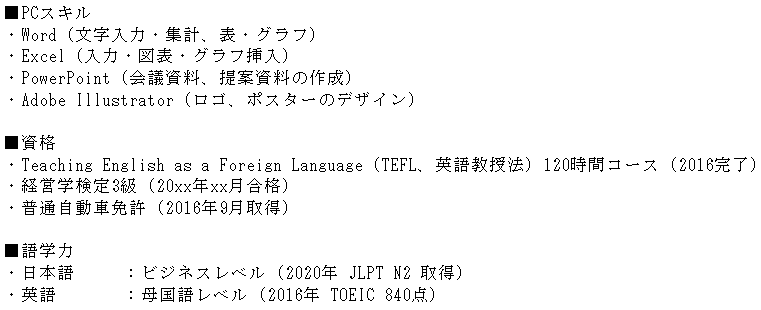Note: If you are an IT engineer, we have a specific article geared for you!
As you put the pieces together for your new life in Japan, you’re certainly used to encountering all manners of cultural and linguistic barriers. Preparing your resume as you apply for jobs presents another cultural barrier: it won’t do just to translate your old resume from your native country, and instead you’ll need to write not one but two new documents from scratch! But no worries: we’re here to help you out through this process.
You Need Two Different Resumes in Japan

When you start your job search in Japan, you will need to prepare a rirekisho (履歴書), which is the Japanese resume. In Japan resumes are highly standardized. Using a two-page template, you fill out your information in the order provided. Besides the basics, your name, age, gender, and a photo, you will also be listing your education, work experience, and skills/certificates. For each of these, you will simply be noting where you were educated/worked, what your positions were, and how long you were at them.
On the second page, there’s a little space for you to sell yourself, noting any special skills or strengths, and a very brief self-introduction/self PR. All-in-all, it reads more like a list of data-points compared to the typical Western resume, which has more room for description and emphasis.
Click here for our tips on how to write a good rirekisho!
In Comes the Shokumukeirekisho

As the resume is very much a bare-bones list of facts, the shokumukeirekisho (職務経歴書) comes in to help flesh your experience out. Unlike the rirekisho, there’s no single universal format for the shokumukeirekisho, and more flexibility as to which sections to condense or combine or strike off altogether.
The purpose of the document is to expand upon the resume, effectively acting as a large footnote. It’s closer to the classic Western CV, but with some elements of the cover letter added on! In this combo, you will take each of your relevant work experiences you listed on your resume, and, in turn, detail exactly what your duties were at each of them, what was significant about them, and why they make you a good fit for the job. It’s also the appropriate place to attach links to a portfolio or other works you’ve made.
Basically, you use the shokumukeirekisho to take your previous work experience into context, and use that to explain how well you fit into the recruiter’s company.
How to Write a Shokumukeirekisho

Despite there being no agreed upon format, there are general guidelines to follow and for what you should include. Here, we’ll walk you through the major categories and show you one possible way to lay out your shokumukeirekisho. As will be mentioned, some sections are essential and should be written as-is, but other sections can be combined or split off depending on what you want to emphasize.
Title and Personal Information
At the top of the page, write out 職務経歴書 as the title. Then, include the date, your name, and other general bits of information like your contact information should you wish. You can download this template and follow along with it for the rest of the article:
Career Summary

Most shokumukeirekisho will include a career summary at the top of the page, just after your information. This will be no longer than 250 characters, and will briefly introduce who you are and what you’ve done professionally up until now. Note, this is not the section to go into depth about your experiences and skills, rather, think of it as an abstract for your career history.
Relevant Skills

This should be a “Best Of” of your skills and accomplishments, a concise list of what you have to offer to the company. It’s not universal to place this here (it’s also possible to group it with the other skills sections toward the bottom; see below), but putting it at the top allows you to make a good impression on the reader. Compared to the skills sections mentioned below, which are dry lists of what you can do and have done, you’re free to phrase these bullet points as you wish.
Career History

This section will be the meat of the shokumukeirekisho. Here, you will go into detail about each of your previous positions. For each job, you can include any number of different points, whatever you feel is most relevant to the position. Remember, this document will be used to determine if you’re a good fit for the company you’re applying to, so use it to highlight experiences you think make you an especially good candidate.
For each position, it’s common to include your previous employer’s information. This can include:
- The company name
- What industry it is in
- When it was founded
- Its capital stock
- Number of employees
- Yearly profit
You only need to include the relevant bits of information. If you didn’t work for a publicly traded company, then there’s no need to provide stock information. Likewise, if you don’t think its founding is all that interesting, there’s no need to include it. This section is less about the prestige of the businesses you worked for, and more about what kind of workplaces you have worked in. Were they big? Small? And what kind of sectors did they deal with?
After detailing each employer, you will then describe what your position was in each company. You can discuss:
- Job title and department
- Duration
- What kind of tasks you handled
- Management experience
- Accomplishments/performance
The importance of this section is to highlight your experiences with each position, your accomplishments, and how they factor into your current application. If you’re applying to a management position, discuss the size and scope of the projects you’ve managed, if you’re applying to something else, emphasize what skills you’ve picked up or utilized that are relevant to this new position.
Again, each position you’ve held will be different, and will impart different skills. Use this section to discuss how each of these positions have readied you for this application and why. If you’re in a creative field and you’ve created something tangible (like websites or designs), you can link to them in the relevant spot as well, allowing your shokumukeirekisho to be something like a portfolio.
Skills

After detailing your career history, you can go over your skills. In these sections, you will cover your specific skillset along with relevant certificates or qualifications. Tailor the skills you’ve listed above in your career history to your current application. What skills have you picked up, and which ones will the company you’re applying to be most interested in? These can range from the very basic to specialist. If you’re applying for an office job, it’s always good to note your experience with desktop applications like Microsoft Office. Likewise, if you’re going into a specialist position, note how many years of experience you’ve had at similar jobs and certificates to back those up. Along with the above, if you’re a non-native Japanese speaker, it’s also good to note your language skill or JLPT level.
You can also list education or other relevant experiences in this section. If your volunteering has given you a specific skillset, or if you took on a work-study program that doesn’t fit neatly into the career history section, you can add them here.
Self-Appeal

Here is a free-flowing area where you can directly state why you’re applying to this position and what your goals are. Go over your past experiences above, the skills you’ve acquired (particularly soft skills, which wouldn’t be mentioned in other sections), where you hope to go in the future, and how this position will help you achieve that. You can discuss anything you want here, but do make sure to hit on the why of this application, as the company you’re applying to will be most interested in knowing what led you to applying to their position and how you can be an asset to the company.
This section shouldn’t be long, about the same length as the career summary at the top of the page—250 characters. Your goal here is to concisely state how this new position fits into your career.
Do note there is a similar section on your rirekisho. If you decide to write both, do not simply copy and paste between the two. They serve different purposes, the rirekisho being more general while the shokumukeirekisho being more targeted. Along with the above, the recruiters at the company will read both and will notice if you didn’t put in the effort.
General Notes

These are some tips that apply to all sections of the shokumukeirekisho when writing. Try to keep them in mind when creating your own.
- You can order your experience as you choose. The most common way is in chronological order, which most Japanese companies prefer. However in some circumstances you can write it in reverse, or ordered based on position seniority to show career growth.
- Try to keep the shokumukeirekisho under two pages if possible. Three is permissible but getting on the long side. However, don’t pad it out to make it longer. One page at the beginning of your career is fine.
- Keep your writing concrete and concise. Make sure your strengths stand out and aren’t hidden behind a veil of flowery or excessive language. Get straight to the point. And when possible, always backup your assertions with numbers.
- Be very assiduous about formatting, such as whether line spacing is consistent, or whether text alignment (left or center justification) is consistent. Japanese recruiters are very picky about visual presentation!
Searching for a Job in Japan Doesn’t Have to Be Difficult

Searching for a new job is always a bit uncomfortable, but the process doesn’t have to be. Hopefully this article has given you the tools to prepare your shokumukeirekisho, helping you check off an absolutely essential box!
In addition to this article compiling all the different ways to find jobs in Japan, our jobs site Tsunagu Local Jobs has a wealth of resources to not only aid in your search, but help you craft the best application possible.
If you want to give feedback on any of our articles, you have an idea that you’d really like to see come to life, or you just have a question on Japan, hit us up on our Facebook!
The information in this article is accurate at the time of publication.

